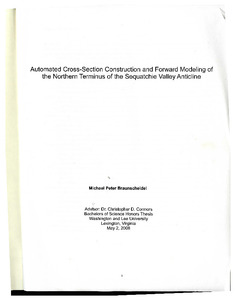| dc.rights.license | In Copyright | en_US |
| dc.creator | Braunscheidel, Michael Peter | |
| dc.date.accessioned | 2023-04-21T19:30:24Z | |
| dc.date.available | 2023-04-21T19:30:24Z | |
| dc.date.created | 2008 | |
| dc.identifier | WLURG038_Braunscheidel_thesis_2008 | |
| dc.identifier.uri | https://dspace.wlu.edu/handle/11021/36170 | |
| dc.description.abstract | Producing a balanced cross-section is a very time and labor intensive process. Balancing of a section requires boundary conditions for both the deformed and undeformed state. A common boundary condition for the undeformed state comes from geologic map data that has been projected by hand into a 2D cross-section. An accurate knowledge of the undeformed state is important to the balancing of a section as this is the starting point that the balancer
works towards. The goal of this project is to reduce the amount of time and labor required to produce accurately balanced sections. One of the long term goals of this project is to develop a work flow that would allow one to balance many sequential structures along the strike of the fold. This allows for the creation of a 3D model that quantifies along strike changes in slip distribution, fold and fault geometries. In order to greatly reduce the amount of time required to produce an accurately balanced cross-section, two different libraries of code were implemented. The first library of code automates the construction of 2D cross-sections that serve as boundary conditions for the deformed state. This library of code extracts a topographic profile, projects digitized attitudes along strike and posts contacts along the line of section. These 2D sections contain an initial estimate for shallow subsurface geometries as contacts posted into the section are oriented according to the average dip of any proximal attitudes projected into the line of section. The second major library of code used is a velocity description of the fault-bend equations that allows one to forward model the structure. Changes in input slip, fault bends and axial surface orientations are made until a forward model is produced that honors the boundary conditions for the deformed state as defined by the automatically produced 2D near surface cross-sections. The use of this methodology required that two major issues be addressed before accurately balanced sections could be produced. The full automation of 2D cross-sections initially estimating shallow subsurface geometries was not possible due to inherent accuracy issues with the original map data. Contacts that were mapped incorrectly on the original map had to be moved to the correct position in the line of section. Additionally, attitudes that project poorly along strike or did not represent the overall structural trend had be be removed from the attitude data set. The need for this two editing capabilities did not allow for strict automation of the 2D cross-section construction. In addition to editing the original map data, it was vital to have an accurate description of the undeformed state. The two most important values for the
undeformed state for the purpose of this project were regional dip and stratigraphic thickness. Since this study modeled multiple sequential sections, it was necessary to calculate any regional thickness trends or change in regional dip value throughout the modeling area. Once all of these issues were addressed, it was possible to produce multiple, sequential balanced cross-sections along the north. eastern terminus of the Sequatchie anticline in Tennessee in a time and labor friendly manner. | en_US |
| dc.format.extent | 121 pages | en_US |
| dc.language.iso | en_US | en_US |
| dc.rights | This material is made available for use in research, teaching, and private study, pursuant to U.S. Copyright law. The user assumes full responsibility for any use of the materials, including but not limited to, infringement of copyright and publication rights of reproduced materials. Any materials used should be fully credited with the source. | en_US |
| dc.rights.uri | http://rightsstatements.org/vocab/InC/1.0/ | en_US |
| dc.subject.other | Washington and Lee University -- Honors in Geology | en_US |
| dc.title | Automated Cross-section Construction and Forward Modeling of the Northern Terminus of the Sequatchie Valley Anticline | |
| dc.type | Text | en_US |
| dcterms.isPartOf | WLURG38 - Student Papers | |
| dc.rights.holder | Braunscheidel, Michael Peter | |
| dc.subject.fast | Folds (Geology) | en_US |
| dc.subject.fast | Rock deformation -- Computer simulation | en_US |
| dc.subject.fast | Geological modeling -- Computer simulation | en_US |
| local.department | Geology | en_US |
| local.scholarshiptype | Honors Thesis | en_US |
